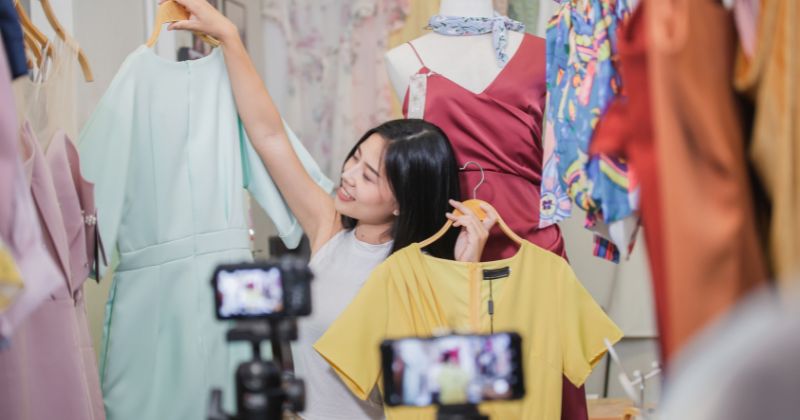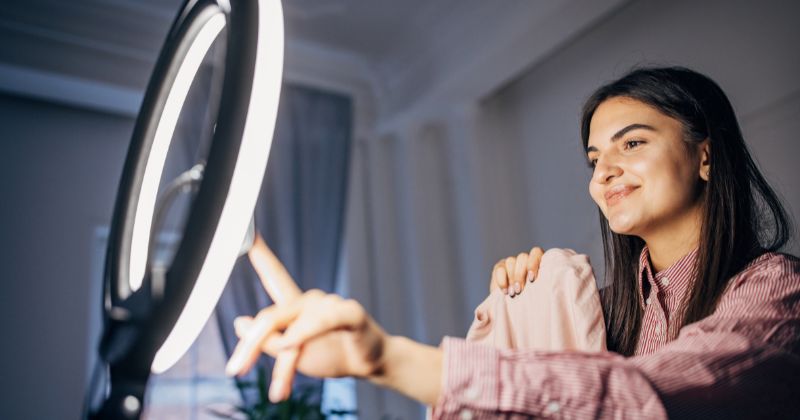Influencers play a crucial role in the fashion industry as they hold significant sway over their followers’ purchasing decisions and can greatly increase a brand’s visibility. Collaborating with brands strategically is a way for fashion influencers to enhance their influence further. This article delves into the advantages of brand partnerships for fashion influencers and how these collaborations foster a mutually beneficial relationship between brands and influencers.

Increased Brand Recognition and Exposure
By partnering with a brand, influencers gain access to a broader audience that might not have known about them otherwise. This increase in exposure can lead to more followers and engagement on social media, ultimately leading to more significant opportunities for monetization. For brands, partnering with influencers can lead to a significant increase in brand awareness. This is especially true for online clothing businesses that rely heavily on social media marketing. Through influencer collaborations, these brands can reach a broader audience and drive more traffic to their websites, ultimately leading to increased sales.
Opportunities for Financial Gain
In the digital age, social media influencers have become pivotal marketing tools for brands looking to expand their reach. By leveraging their substantial follower bases, influencers can effectively promote products or services. The partnerships forged between influencers and brands are structured around various payment models, each with its own set of benefits and considerations:
- Flat Fees: This straightforward payment model involves a predetermined sum paid upfront to influencers. Typically used when brands seek to maintain budget certainty, flat fees ensure that influencers are compensated regardless of the campaign’s performance metrics such as views, clicks, or sales. This model is particularly appealing for established influencers who can demand higher rates due to their proven impact and reach.
- Commission-Based: Under this model, influencers earn a percentage of the sales or a commission for each lead generated through their promotional efforts. This payment structure aligns the interests of the brand and the influencer, as earnings are directly tied to the campaign’s success. It encourages influencers to create compelling content and actively engage their audience to maximize their earnings.
- Product Exchanges: Instead of monetary compensation, influencers receive free products or services. This arrangement is often preferred by new influencers or those in niche markets where tangible products can add personal value and enhance content authenticity. It’s a cost-effective method for brands, especially those that are startups or have limited marketing budgets. Influencers benefit by gaining access to products they can showcase, review, and integrate into their content, which can also help them maintain the genuineness of their endorsements.
These payment structures allow brands and influencers to find the right fit based on campaign goals, budget constraints, and target outcomes, making collaborations flexible and adaptive to changing market dynamics. As the influencer marketing landscape continues to evolve, these models provide the foundation for creating successful and scalable partnerships that benefit both parties and their audiences.
When it comes to online fashion businesses, influencer collaborations are an excellent way to boost sales. With the rise of social commerce, consumers are more likely to purchase products that have been recommended by influencers they follow. By partnering with influencers, online clothing businesses can reach a broader audience and ultimately drive more sales.
Access to Exclusive Products and Events
Brand partnerships provide fashion influencers with unique access to exclusive products and events, which significantly enhances their content creation capabilities and engagement levels. By collaborating with brands, influencers often receive early access to products that have yet to hit the market. This exclusive opportunity allows them to create anticipatory content that generates buzz among their followers, who are eager to learn about the latest trends and innovations. Influencers can craft detailed reviews, unboxing videos, and styling guides, showcasing the new products in a way that highlights their features and benefits.
These partnerships often extend beyond product previews to include invitations to exclusive brand events. Fashion influencers frequently attend launch parties, fashion shows, and private brand gatherings where they can mingle with industry leaders, designers, and other influencers.
In addition to exclusive products, fashion influencers can also gain access to exclusive events through brand collaborations. These events are often hosted by the brand to promote their products and allow influencers to network with other industry professionals. Attending these events can be a great way to build relationships and gain exposure in the industry.
Enhancement of Personal Brand Image
Partnering with reputable brands can also enhance the personal brand of fashion influencers. By collaborating with established brands, influencers can showcase their expertise in the industry and position themselves as industry leaders. This can ultimately lead to more significant opportunities for monetization and brand collaborations. Working with reputable influencers can add credibility to their products and services. When a respected influencer endorses a brand, consumers are more likely to trust that brand and make a purchase. This can be especially beneficial for new or lesser-known brands trying to establish themselves in the market.

Creating a Symbiotic Relationship Between Brands and Influencers
Ultimately, brand collaborations create a symbiotic relationship between brands and influencers. By working together, both parties can benefit from increased exposure, monetization opportunities, and access to exclusive products and events. Building relationships is essential for successful brand collaborations. By establishing a strong relationship with a brand, influencers can position themselves as valuable partners and increase their chances of future collaborations. Likewise, brands that invest in building relationships with influencers can benefit from long-term partnerships and a loyal fan base.
To ensure the success of brand collaborations, adopting a clear strategic approach is essential. This structured plan helps both brands and influencers to align their efforts, ensuring that every step taken is purposeful and effective. The key components of this strategy include:
- Setting Specific Goals: A successful collaboration begins with the establishment of clear, measurable objectives. Both parties should agree on what they aim to achieve, whether it’s increasing brand awareness, boosting sales, or expanding into new markets. Setting specific goals allows for the creation of focused content and marketing strategies. It also provides a benchmark against which to measure the success of the collaboration, ensuring that both brands can see the tangible results of their efforts. Goals should be SMART: Specific, Measurable, Achievable, Relevant, and Time-bound, to facilitate effective monitoring and adjustment of strategies as needed.
- Identifying the Target Audience: Understanding who the collaboration aims to reach is crucial. This involves analyzing both brands’ current market segments and identifying potential new audiences that could be engaged through the partnership. Detailed audience profiles, including demographic, psychographic, and behavioral traits, should be developed. This ensures that the messaging and content are tailored to resonate well with the audience, increasing engagement and conversion rates. Knowing the audience helps in selecting the right channels and methods for distribution, maximizing reach and impact.
- Determining Content-Type: Deciding on the form and message of the content is pivotal in engaging the audience effectively. This decision should align with the brands’ identities, campaign goals, and audience preferences. Options may include video tutorials, informative blog posts, interactive social media campaigns, or co-branded products. The content should not only appeal to the audience but also reinforce the brands’ values and market position. Creative, well-executed content can significantly enhance visibility and perception, making the collaboration memorable and impactful.
Having a well-defined strategy enables both brands and influencers to maximize the benefits of their partnerships. With a solid plan in place, brand collaborations can evolve into powerful, mutually beneficial relationships that drive growth and innovation in an increasingly competitive market.
Brand collaborations are a crucial part of fashion influencing and offer many benefits to both influencers and brands. By working together, influencers and brands can increase exposure, drive sales, access exclusive products and events, and enhance their personal brands. To be a successful fashion influencer, it is essential to understand the power of brand collaborations and how to monetize your influence effectively.
One of the best ways to start monetizing your influence is by joining a creator platform. These platforms act as intermediaries between influencers and brands, streamlining the process of finding collaboration opportunities. To begin, an influencer needs to sign up and create a compelling profile that showcases their unique style, niche, and audience demographics. This profile is crucial as it represents the influencer to potential brand partners. High-quality content samples, a well-documented engagement rate, and a clear presentation of audience demographics enhance an influencer’s appeal, making them more attractive to brands looking for specific market segments. Many of these platforms offer tools and analytics that help influencers understand their audience better, enabling them to tailor their content effectively and increase engagement. Beyond just connecting with brands, advanced features on some creator platforms can significantly boost an influencer’s career. For instance, educational resources on optimizing content for SEO, maximizing platform-specific algorithms, or engaging effectively with audiences can refine an influencer’s skills and strategic approach.
Some platforms provide contract management tools and secure payment channels that simplify the business side of collaborations, ensuring transparency and trust between brands and creators. Networking features, like community forums and events, also play a vital role, as they allow influencers to connect with peers, exchange ideas, and form partnerships that can lead to collaborative growth opportunities. These additional features make creator platforms not just a marketplace for transactions but a comprehensive ecosystem supporting an influencer’s career development.
Transparency in influencer marketing is critical, especially as audiences today are increasingly wary of traditional advertising techniques and can be skeptical of influencer endorsements. When influencers openly acknowledge their brand relationships, they reassure their audience that they are genuine in their endorsements and not merely motivated by profits. This transparency helps maintain the authenticity that likely drew followers to them in the first place. Influencers can use several strategies to ensure transparency:
- Incorporate Disclosures In Content: Including disclosures directly within the content ensures that the audience immediately understands the nature of the collaboration. For instance, an influencer might say, “Thanks to [Brand] for sponsoring this post” at the beginning of a video or blog post. This approach makes the sponsorship evident from the outset, preventing any potential confusion about the content’s nature. By weaving these acknowledgments naturally into their content, influencers can maintain a seamless flow while upholding transparency. This practice not only complies with advertising guidelines but also fosters trust between the influencer and their audience.
- Use Relevant Hashtags: Hashtags like #ad or #sponsored are straightforward ways to disclose partnerships on social media. These tags are easily recognizable and immediately signal to followers that the post is a paid collaboration. Including these hashtags in captions or descriptions makes it clear that the influencer is promoting a brand or product. This method is particularly effective on platforms like Instagram and Twitter, where hashtags are a common part of the user experience. By using relevant hashtags, influencers can maintain transparency without significantly altering their content’s format or appeal.
- Leverage Platform Features: Many social media platforms offer built-in features that allow influencers to tag posts as sponsored. These features automatically add a disclosure, such as “Paid partnership with [Brand],” above the post. This integration ensures that the sponsorship is immediately visible to all viewers, enhancing transparency. Utilizing these tools not only simplifies the disclosure process for influencers but also aligns with platform guidelines.
- Educate Followers On Partnerships: Educating followers about the importance of partnerships can help maintain a positive relationship. Influencers can explain why these collaborations are vital for supporting their content, allowing them to continue creating and sharing their passions. This education can be done through posts, stories, or even dedicated sections on their websites. When followers understand that sponsored content helps sustain their favorite creators’ channels, they are more likely to appreciate and support these partnerships. Transparent communication about the role of sponsorships fosters a more supportive and engaged audience.
These methods help maintain transparency and positive relationships with followers, who often appreciate understanding how their favorite creators sustain their channels. By adopting these strategies, influencers can ensure that their disclosures are effective and that their audiences remain informed and trusting.

Brand collaborations are a powerful tool for fashion influencers looking to maximize their influence and monetize their social media presence. By partnering with reputable brands and building strong relationships, influencers can establish themselves as leaders in the industry and create long-term monetization opportunities. With the rise of social commerce and online fashion businesses, the potential for influencer collaborations is only growing, making it an exciting time to be a fashion influencer.
